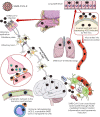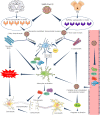Emerging COVID-19 Neurological Manifestations: Present Outlook and Potential Neurological Challenges in COVID-19 Pandemic
- PMID: 34169443
- PMCID: PMC8224263
- DOI: 10.1007/s12035-021-02450-6
Emerging COVID-19 Neurological Manifestations: Present Outlook and Potential Neurological Challenges in COVID-19 Pandemic
Abstract
The unremitting coronavirus disease 2019 (COVID-19) pandemic caused by the novel severe acute respiratory syndrome coronavirus 2 (SARS-CoV-2) marked a year-long phase of public health adversaries and has severely compromised healthcare globally. Early evidence of COVID-19 noted its impact on the pulmonary and cardiovascular functions, while multiple studies in recent time shed light on its substantial neurological complications, though a comprehensive understanding of the cause(s), the mechanism(s), and their neuropathological outcomes is scarce. In the present review, we conferred evidence of neurological complications in COVID-19 patients and shed light on the SARS-CoV-2 infection routes including the hematogenous, direct/neuronal, lymphatic tissue or cerebrospinal fluid, or infiltration through infected immune cells, while the underlying mechanism of SARS-CoV-2 invasion to the central nervous system (CNS) was also discussed. In an up-to-date manner, we further reviewed the impact of COVID-19 in developing diverse neurologic manifestations associated with CNS, peripheral nervous system (PNS), skeletal muscle, and also pre-existing neurological diseases, including Alzheimer's disease, Parkinson's disease, multiple sclerosis, epilepsy, and myasthenia gravis. Furthermore, we discussed the involvement of key factors including age, sex, comorbidity, and disease severity in exacerbating the neurologic manifestations in COVID-19 patients. An outlook of present therapeutic strategies and state of existing challenges in COVID-19 management was also accessed. Conclusively, the present report provides a comprehensive review of COVID-19-related neurological complications and emphasizes the need for their early clinical management in the ongoing COVID-19 pandemic.
Keywords: CNS; COVID-19; COVID-19 pandemic; Neuroinvasion; Neurological complications; PNS; SARS-CoV-2.
© 2021. The Author(s), under exclusive licence to Springer Science+Business Media, LLC, part of Springer Nature.
Conflict of interest statement
The authors declare no competing interests.
Figures




Similar articles
-
Evidence of Coronavirus (CoV) Pathogenesis and Emerging Pathogen SARS-CoV-2 in the Nervous System: A Review on Neurological Impairments and Manifestations.J Mol Neurosci. 2021 Nov;71(11):2192-2209. doi: 10.1007/s12031-020-01767-6. Epub 2021 Jan 19. J Mol Neurosci. 2021. PMID: 33464535 Free PMC article. Review.
-
Neurological manifestations associated with SARS-CoV-2 and other coronaviruses: A narrative review for clinicians.Rev Neurol (Paris). 2021 Jan-Feb;177(1-2):51-64. doi: 10.1016/j.neurol.2020.10.001. Epub 2020 Dec 16. Rev Neurol (Paris). 2021. PMID: 33446327 Free PMC article. Review.
-
Neurological complications caused by SARS-CoV-2.Clin Microbiol Rev. 2024 Dec 10;37(4):e0013124. doi: 10.1128/cmr.00131-24. Epub 2024 Sep 18. Clin Microbiol Rev. 2024. PMID: 39291997 Review.
-
Comprehensive Review on Neuro-COVID-19 Pathophysiology and Clinical Consequences.Neurotox Res. 2021 Oct;39(5):1613-1629. doi: 10.1007/s12640-021-00389-z. Epub 2021 Jun 25. Neurotox Res. 2021. PMID: 34169404 Free PMC article. Review.
-
Neurological and Neuropsychiatric Impacts of COVID-19 Pandemic.Can J Neurol Sci. 2021 Jan;48(1):9-24. doi: 10.1017/cjn.2020.173. Epub 2020 Aug 5. Can J Neurol Sci. 2021. PMID: 32753076 Free PMC article. Review.
Cited by
-
SARS-CoV-2 mediated neurological disorders in COVID-19: Measuring the pathophysiology and immune response.Life Sci. 2022 Nov 1;308:120981. doi: 10.1016/j.lfs.2022.120981. Epub 2022 Sep 21. Life Sci. 2022. PMID: 36150465 Free PMC article. Review.
-
Neurological manifestations and complications of COVID-19 in patients admitted to a tertiary care center in Nepal during the second wave.Medicine (Baltimore). 2024 Feb 16;103(7):e36017. doi: 10.1097/MD.0000000000036017. Medicine (Baltimore). 2024. PMID: 38363915 Free PMC article.
-
SARS-CoV-2 Possible Etiology of Cerebral Venous Thrombosis in a Teenager: Case Report and Review of Literature.Viruses. 2023 Jan 31;15(2):405. doi: 10.3390/v15020405. Viruses. 2023. PMID: 36851619 Free PMC article. Review.
-
Health-related quality of life (HRQoL) and psychological impact of the COVID-19 pandemic on patients with myasthenia gravis.Intractable Rare Dis Res. 2023 May;12(2):88-96. doi: 10.5582/irdr.2023.01003. Intractable Rare Dis Res. 2023. PMID: 37287657 Free PMC article.
-
Neurological Manifestations and Complications of the Central Nervous System as Risk Factors and Predictors of Mortality in Patients Hospitalized with COVID-19: A Cohort Study.J Clin Med. 2023 Jun 15;12(12):4065. doi: 10.3390/jcm12124065. J Clin Med. 2023. PMID: 37373759 Free PMC article.
References
Publication types
MeSH terms
Grants and funding
LinkOut - more resources
Full Text Sources
Medical
Miscellaneous

